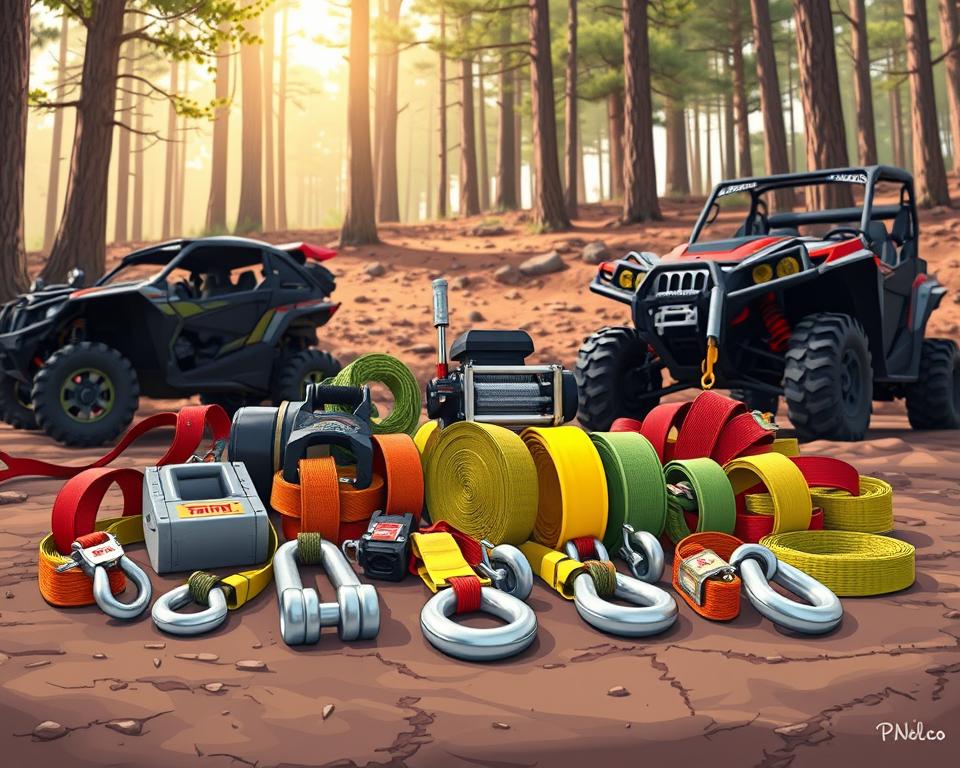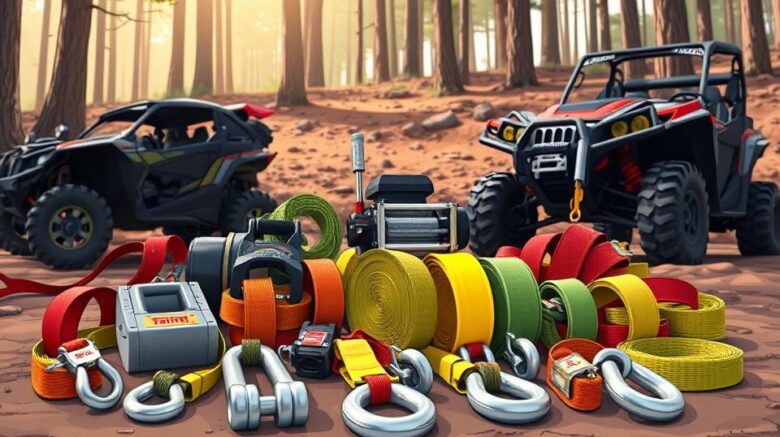Avoiding ATV/UTV Gearing Mistakes for Newbies
It might surprise you to discover that nearly 30% of new ATV and UTV owners face gear selection issues within their first year? This statistic underlines the importance of grasping ATV gear ratios for beginners. Correct gear choice protects against accidents as well as enhances power. Let’s dive into gearing missteps, care routines, and top moose parts tips to enhance your rides.
Key Takeaways

- Mastering gear ratios unlocks top performance.
- Typical gear mistakes compromise safety on uneven ground.
- Scheduled upkeep stops gearbox failures.
- Choosing the right gear boosts trail enjoyment.
- Implementing ATV maintenance tips can prolong vehicle lifespan.
Understanding ATV and UTV Gear Ratios
Gear ratios are vital for the performance of ATVs and UTVs. They shape acceleration and pulling strength. That impacts hill climbs and tow capabilities. By picking specific ratios, you tailor your ride for drag, trail, or work.
Choosing the right UTV gear is key to understanding engine performance. Too low a ratio may leave you underpowered on inclines. Conversely, too high a ratio hampers quick takeoffs on flats.
Many enthusiasts use gear reduction to enhance handling and adaptability across different terrains. By adjusting gear ratios, riders can customize their vehicle’s performance. It perfectly aligns performance with your riding style. Finding the sweet spot in gearing enhances ride quality and fuel economy.
Common Gearing Oversights for New ATV/UTV Owners
Correct gearing secures top output and trail safety. Rookies often miss key selection factors. Grasping misgear consequences and correct choices elevates your performance. And it sidesteps needless breakdowns.
Impact of Incorrect Gear Selection
Wrong ratios threaten stability and component life. Incorrect ratios reduce pulling power, hamper braking, and grind parts. These mishaps compromise safety for all on and off board. Using maintenance best practices wards off these hazards.
Choosing the Right Gear for Terrain
Different terrains need different gearing for efficient performance. Climbing requires low-end grunt from smaller ratios. To cover ground quickly, shift to higher ratios. Soft ground demands careful gear choice for grip. Understanding trail types secures fun and safety.
The Importance of Proper ATV Maintenance
Regular maintenance is key to keeping ATVs and UTVs running smoothly. Following ATV maintenance tips helps avoid unexpected breakdowns and boosts safety. A tailored service plan prioritizes drivetrain care.
Regular Inspection and Maintenance
Using a checklist uncovers faults before they escalate. Regularly inspect the drive train, stopping systems, wheels, and belts. Routine checks lead to peak performance. Here are some critical inspection points to remember:
- Check gear mesh and teeth condition.
- Check for loose bolts or connections.
- Check master cylinder and calipers for leaks.
- Inspect tire pressure and tread depth.
- Inspect battery terminals and cables for buildup.
Fluid Changes and Gear Health
Clean fluids keep transmissions and differentials happy. Regularly changing engine oil, gear oil, and coolant prevents grime buildup. Pure coolant and oil lower temperatures and prolong service intervals. Using this method secures dependable function and fewer breakdowns.
| Fluid Type | Recommended Change Interval | Benefits of Regular Change |
|---|---|---|
| Engine Oil | 50–100 operating hours | Cuts friction and boosts power |
| Gear Oil | Every 100-200 hours | Improves shifting, minimizes gear damage |
| Antifreeze | Once per year | Stops boil-overs and freezes |
Adhering to this schedule grants worry-free adventures. It turns rides into stress-free experiences.
Common ATV Gear Shifting Problems
Many beginners wrestle with the gearbox. Developing fluid shift skills elevates trail enjoyment. This stops shift-related aggravation. Timing throttle and clutch releases prevents gears from crunching.
Learning to Shift Smoothly
Developing smooth shifting techniques requires a few practices. Start by getting to know your ATV engine’s rhythm. Careful engagement protects internals and stops wear. Timing your throttle input when releasing the clutch is critical.
Drill shifts in an open space to build skill. Apply minimal throttle for smooth transitions.
Recognizing Signs of Gear Issues
Spotting problems early prevents breakdowns. Be alert for clicks, clunks, or grinds when shifting. Hard shifts or missed gears indicate trouble. Addressing issues promptly protects components and riders. Resolving shift issues preserves power delivery and morale.
Understanding UTV Transmission Issues
Dealing with UTV transmission problems can be tough, but knowing the common issues is vital for troubleshooting. Typical troubles involve gears that slip and grinding sounds. Here we examine usual faults and outline a step-by-step fix plan. It’s based on a practical UTV troubleshooting guide.
Diagnosing Common Problems
Recognizing the signs of transmission troubles is essential. Common issues include:
- Gears that pop out under load, risking accidents.
- Strange noises signaling internal wear.
- Drips or puddles under the UTV may foretell failures.
Scheduled inspections catch problems fast. This allows for prompt action. Missing early clues damages your ride and wallet.
Solutions for Troubleshooting UTV Transmissions
Fixing UTV transmission issues requires a systematic approach. Follow these steps for effective troubleshooting:
- Ensure gearbox fluid is at spec, then add if low.
- Inspect pan and seals for drips.
- Inspect the gearbox for wear or damage.
- Test drive the UTV at various speeds to monitor gear engagement and responsiveness.
- Consult the owner’s manual for specific diagnostics related to your model.
Following a reputable repair manual simplifies diagnosis. Understanding gear mechanics is key for any UTV owner. That insight preserves reliability and output.
ATV Clutch Adjustments and Their Benefits
Right clutch settings smooth out gear changes. Incorrect adjustments can make shifting gears tough, frustrating for beginners. Routine calibration refines clutch response and engagement.
Precision in gear changes is critical. A well-set clutch delivers fast, clean shifts. It refines acceleration and comfort across all conditions.
Skipping clutch care leads to early failures and poor shifts. Consistent adjustments sustain peak clutch function. All riders benefit from clutch care to maintain top performance.
Mastering the Art of Gear Shifting
Excelling at transitions elevates your trail adventures. It requires knowledge of your vehicle’s mechanics and developing a keen sense of timing and spatial awareness. Novices must learn shift cadence. A comfortable cadence leads to smoother transitions and improved performance.
Proficient gear shifting demands practice, across various riding conditions. Recognizing terrain-specific shift cues boosts confidence and protection. For instance, shifting down when approaching a steep hill helps maintain power and stability.
- Practice shifting at low speeds to build confidence.
- Note engine tone and drivetrain reaction.
- Step up to steeper, rougher trails as you improve.
Tuning into your ATV’s feedback is key to shift mastery. Pay attention to engine sounds and vibrations. These cues pinpoint exact shift timing. Such intuitive understanding leads to proficient gear shifting, making your ride more enjoyable.
Best Practices for UTV Gear Selector Problems
Resolving gear lever faults requires regular inspection and testing. Routine linkage reviews catch wear promptly. Learning proper lever use minimizes failures. Routine checks should include visual inspections of the selector linkage and fluid levels, which are vital for performance.
When facing gear selector issues, first check the selector mechanism for obstructions or damage. Clunks or rattles can signal a loose linkage. Minor tweaks typically fix selector snags. A routine plan stops small faults from growing.
Using a systematic approach, like documenting gear performance under different conditions, helps identify specific problems. These best practices not only extend the gear selector’s life but also make riding safer and more enjoyable.
Tips for Enhancing Gear Performance
Maintaining optimal gear performance requires a proactive approach. Regular maintenance is key to improving ATV efficiency. It’s important to check fluid levels, inspect for wear, and adjust settings as needed. Spotting wear early stops expensive overhauls.
Selecting proper reductions yields prompt acceleration and fluid movement. Knowing trail types steers your ratio choices. It influences your launch and maximum velocity. Seeking parts from specialists such as American Off-Roads aids in UTV performance enhancements.
Utilizing gear performance tips focused on tire selection, suspension adjustments, and weight distribution can further improve overall gear efficiency. These tweaks guarantee superior handling in rough conditions. This leads to a more enjoyable riding experience. By using these methods, you’ll tackle trails boldly and relish every moment.
Bringing It All Together
Mastering ATV/UTV gearing is essential for performance and safety. Matching gears to ground types transforms your adventure. Dodging typical pitfalls and choosing wisely delivers memorable, safe outings.
You can’t overemphasize regular service for power health. Routine inspections and care fend off failures and boost lifespan. Good upkeep maximizes output and secures your rides in all conditions.
Combining correct gearing with scheduled service delivers peak satisfaction for riders. Embracing these tips sets the stage for countless epic journeys.
FAQ
What are the typical gear ratios for ATVs and UTVs?
ATVs and UTVs have gear ratios that vary widely, depending on the model. They usually range from 3:1 to 5:1. Low-end ratios yield higher pulling power. Higher ratios, on the other hand, can increase top speed on flat terrain.
How can I determine if I’m using the wrong gear for my terrain?
Wrong ratios cause skiddy control, engine lugging, or weak pull. Each terrain type—mud, sand, rock, or snow—requires specific gear selection for optimal performance.
How to know when your machine needs service?
Head off issues if shifts go crunchy, the box hums, oil drips, or power falls off. Periodic drive train reviews ward off costly repairs.
Recommended fluid change intervals?
Change the gear fluids every 1,500 to 2,500 miles, or at least once a year, depending on usage and terrain. Fresh fluids promote crisp shifts and gearbox longevity.
What techniques should I use for smooth gear shifting?
For smooth gear shifting, practice coordinating the throttle and clutch. Gradually release the clutch while pressing the throttle to match engine speed with wheel speed.
Steps to diagnose gearbox problems?
Begin with fluid level checks and a listen for whines or grinds. Inspect the transmission fluid level and condition. Next, test-drive at varied speeds to see how it shifts.
What is the importance of clutch adjustments in an ATV?
Well-set clutches ensure crisp gear changes. Incorrect clutch setup strains the gearbox and causes sticky shifts.
Adapt gearing for every surface?
Try different ratio setups and check out trusted upgrades from American Off-Roads. Routine upkeep—fluid swaps and gear checks—boosts efficiency.
Addressing a bad gear selector?
Regular inspections and routine maintenance are key. If you encounter issues with a stuck selector or improper gear engagement, consult the troubleshooting guide in your owner’s manual for step-by-step diagnostics.
Rookie gearing errors to dodge?
New owners often overlook the importance of understanding gear ratios, neglect routine maintenance, or fail to adjust gears according to terrain. These mistakes hamper performance and raise the chance of mishaps.
